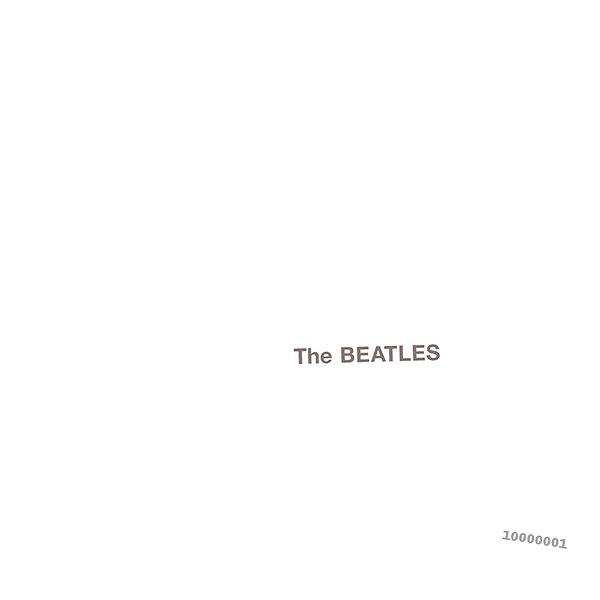Forty-five years ago this month The Beatles released the double-album The Beatles - their ninth in six years. More commonly referred to as ‘The White Album’ (due to artist Richard Hamilton’s minimalist sleeve cover), it was the follow up to their ground-breaking magnum opus Sgt. Pepper’s Lonely Hearts Club Band.
In February 1968 The Beatles, their wives and entourage flew out to India to stay at the Maharishi Yogi’s meditation camp in Rishikesh following a meeting in London. They then travelled to Wales for a 10 day conference on Transcendental Meditation. Other guests in India included members of the Beach Boys and Donovan.
Perhaps most significantly, following The Beatles truly heroic intake of illegal narcotics over the last few years the band were now virtually drug-free. This allowed them to take in the Himalayan air and relax, while armed only with their Martin D-28 acoustic guitars the group returned to England in April with around 40(!) new songs.
Starr left after ten days complaining of home-sickness while McCartney left after four weeks due to other commitments. Lennon and Harrison both stayed for around six weeks when they left abruptly following accusations of inappropriate behaviour by the Maharishi to Mia Farrow. The song 'Sexy Sadie' was initially called 'Maharishi' and Lennon not wanting to become embroiled in a court case renamed the song on Harrison's insistence.
Perhaps most significantly, following The Beatles truly heroic intake of illegal narcotics over the last few years the band were now virtually drug-free. This allowed them to take in the Himalayan air and relax, while armed only with their Martin D-28 acoustic guitars the group returned to England in April with around 40(!) new songs.
Starr left after ten days complaining of home-sickness while McCartney left after four weeks due to other commitments. Lennon and Harrison both stayed for around six weeks when they left abruptly following accusations of inappropriate behaviour by the Maharishi to Mia Farrow. The song 'Sexy Sadie' was initially called 'Maharishi' and Lennon not wanting to become embroiled in a court case renamed the song on Harrison's insistence.
 |
| The Beatles in India |
In truth when the album was recorded the band was in turmoil - it being the first album released since the suicide of the group’s manager Brian Epstein. Ringo Starr briefly quit the band leaving Paul McCartney to play the drums on a few songs, with Macca putting in a particularly ebullient - if initially stiff performance on 'Dear Prudence', building the track to a particularly cathartic climax. As well as tensions between bandmates, the Abbey Road sessions were also coloured by the presence of John Lennon’s new muse: Yoko Ono.
Of the 30 songs featured on the album only 13 featured all four members performing together, with the chief writer usually taking care of his own composition - indeed The Beatles were now beginning to work as solo artists, exploring their own talents. Indeed, the working title of the album was (rather appropriately) ‘A Doll’s House’ (presumably after the Ibsen play), however, by coincidence the band Family released their album Music In A Doll’s House in the same year.
Such was the prolific output of the group during this period several compositions didn’t make it onto The Beatles. Here are three songs written in India that didn’t make the cut, yet found themselves on future solo albums following the breakup of the band.
Child of Nature (Lennon)
'Child of Nature' was recorded along with 22 other songs on a two-track recorder at George Harrison’s house in Esher before the band returned to Abbey Road to work on The Beatles. The song, along with McCartney’s 'Mother Nature’s Son', was inspired by a lecture given by the Maharishi about a ‘son of nature.’ Interestingly, despite the acrimonious end to The Beatles stay in India Lennon sings fondly of India:
Underneath the mountain ranges
Where the wind that never changes
Touch the windows of my soul
Touch the windows of my soul
I'm just a child of nature
I don't need much to set me free
I'm just a child of nature
I'm one of nature's children
Following a change of lyrics and a tighter chord sequence, the song eventually became on of Lennon’s most famous solo compositions 'Jealous Guy', appearing his 1971 album Imagine.
Underneath the mountain ranges
Where the wind that never changes
Touch the windows of my soul
Touch the windows of my soul
I'm just a child of nature
I don't need much to set me free
I'm just a child of nature
I'm one of nature's children
Following a change of lyrics and a tighter chord sequence, the song eventually became on of Lennon’s most famous solo compositions 'Jealous Guy', appearing his 1971 album Imagine.
Junk (McCartney)
Also recorded at Harrison’s house in Esher, this McCartney demo (initially titled ‘Jubilee’) is virtually identical both musically and lyrically to the version released on his debut solo album McCartney (1970).
Not Guilty (Harrison)
While an acoustic demo features on the Esher demos, this full band version of Harrison’s Not Guilty was recorded at Abbey Road took around 100 takes over three days to get to this stage. Such was the complexity of its arrangement the band struggled to cope with its aggressive chord changes, awkward time signatures and erratic rhythm. 'Not Guilty' is perhaps the most Lennon-like song Harrison wrote (see Lennon's 'Happiness is a Warm Gun' from The Beatles), but its problems were never fully overcome. A less appealing version of the song (with an extra verse) had to wait until 1979 for its official release on the author’s eponymous solo album. A heavily edited version of the track appeared on Anthology 3 the 1990's television documentary series and its accompanying three double albums of unreleased - yet widely bootlegged music.
